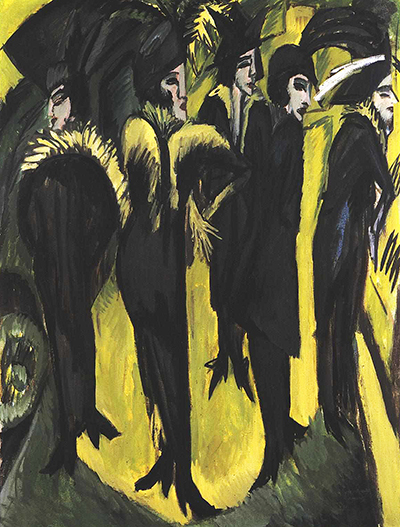Five Women in the Street was an early work in a famous series of paintings by Ernst Ludwig Kirchner which capture the seedier side of city life in Berlin and Dresden.
The elaborate headwear of the women in this scene is almost like plumage of an attractive set of birds. These are prostitutes, but displayed in a style that is flattering and positive, which Kirchner repeats in a number of other similar paintings. The artist made use of small palettes of colour in many of his paintings, but this is even more so that case in this painting, where only yellows, whites and black are used. The three provide a bold contrast between each other and provide an overall piece which is striking and enticing.
The women look across to the right, perhaps into a nearby shop window, or perhaps instead looking out for some business. There is also the wheel of a car to the left, perhaps someone looking to hire one of these glamorous women for the evening. One can come up with different understandings of this composition - one the one hand the women look desirable and elegant, whilst on the other they are placed into a trapped space, between client and store. A satisfactory conclusion can only be drawn by looking into the characteristics of other works in this series by Kirchner, including the likes of Berlin Street Scene, Street, Berlin and Street, Dresden.
The output of paintings based on city life lasted from around 1913-1916 in Berlin before later taking in Dresden a few years later. The artwork displayed here is one of the first in that collection and Kirchner also later produced a woodblock print of the same name which resides in the National Gallery of Art in Washington, US. That one is dated from 1914, and follows a similar but not identical composition. The background on the woodblock is also less detailed than the oil painting here that came one year earlier.




